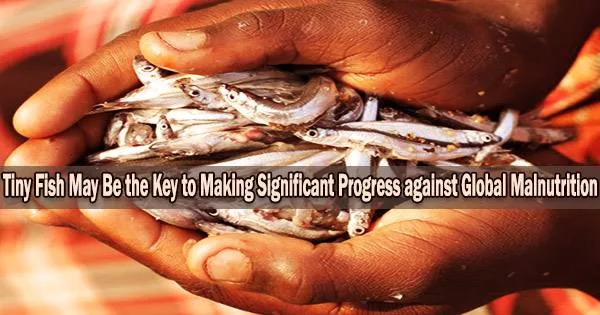Small fish, often called “micro-livestock,” can be a key ingredient in fighting global malnutrition. They are a source of high-quality protein, essential vitamins, and minerals, and can be farmed with limited resources.
Additionally, they can be raised in small ponds and tanks, making them accessible to communities in rural areas where traditional livestock may be difficult to raise. Tiny fish could play a big part in tackling malnutrition and the food insecurity crisis across the globe, a new study reveals.
Researchers have discovered that small species like herring, sardines, and anchovies are the cheapest source of nutrient-dense fish available in many low- and middle-income countries and are frequently caught in great quantities in the waterways of countries where people are suffering from malnutrition.
Given that over 3 billion people currently reside in Southern Asia and sub-Saharan Africa and are unable to afford a good nutritious meal, these findings are crucial. Essential micronutrient deficiencies are on the rise globally and are associated with illnesses like maternal mortality and stunted growth.
Malnutrition is rising in sub-Saharan Africa, and in 2020 10 million children suffered wasting and 55 million children were stunted through inadequate diets. But according to a recent study led by researchers from Lancaster University and published in the journal Nature Food, in sub-Saharan Africa, 20% of the locally caught small pelagic fish could feed all children under the age of five who reside near lakes or the sea with a daily serving of nutrient-rich seafood.
Dr. James Robinson, of Lancaster university and who led the study, said: “Our findings show that nutrients critical to tackling malnutrition are within the reach of vulnerable people living nearby coastal and freshwater ecosystems across the globe.”
“These small locally-caught fish are packed with nutrients key for sustaining healthy diets, are already caught in sufficient numbers, and are affordable. Small pelagic fisheries must be fished sustainably, and catches must reach vulnerable local populations.”
The study is a component of the “Illuminating Hidden Harvests” project, where an international team of researchers and fisheries scientists gathered information on catch numbers, economic data, and nutrient data for almost 2,350 species, or over two-thirds of all fish caught globally.
Fish is a key animal food in the Global South, providing a local and cheap source of micronutrients such as iron and zinc. Governments and other institutions have lacked sufficient data on which fish species would deliver the biggest benefits for public health, until now.
Dr. Kendra Byrd
The results ranked the most reasonably priced and nutrient-dense fish in 39 low and middle-income nations, and they will assist shape public health and fisheries strategies in areas with a dearth of information on fish nutrition.
These little species, known as pelagic fish because of the region of seas and lakes where they are located, strike a perfect balance between being very nutrient-dense, easily captured, and, most importantly, being the most reasonably priced fish, particularly in low-income nations.
Small pelagic fish are up to twice as economical as other fish species and are higher in iron, zinc, calcium, omega-3 fatty acids, and selenium. In 28 of the 39 countries examined, herrings, sardines, and anchovies were discovered to be the least expensive nutrient-dense fish. The least cost species were found to be cold-water demersal species like cod and flounder.
The cost of the cheapest local basic foods, like rice or root vegetables, was used to compare the affordability of various fish. The researchers were able to compare fish costs in nations with various income levels and food systems as a result.
Co-author Dr. Kendra Byrd of the University of Greenwich Natural Resources Institute said, “Fish is a key animal food in the Global South, providing a local and cheap source of micronutrients such as iron and zinc. Governments and other institutions have lacked sufficient data on which fish species would deliver the biggest benefits for public health, until now.”
“Prioritising small pelagic fish for consumption by local vulnerable people, such as children, mothers or the elderly, can help to address common nutrient deficiencies such as calcium, iron and zinc, delivering huge public health benefits.”
The overfishing of these little fish, as well as competing global demand from sectors like animal feed and fish oil, as well as foreign demand, pose challenges to the availability of these small fish, according to the researchers.
Dr. Godfred Asiedu, of Ghana Fisheries Recovery Activity and who was another co-author on the research, said: “The need for locally accessible, cheap, and nutritious food sources has never been greater. Our study helps to shine a light on the ‘hidden’ environmental, social, economic and governance contributions of small-scale fisheries, focusing attention on the importance of policy making for sustainable and equitable management of small-scale fisheries.”
















